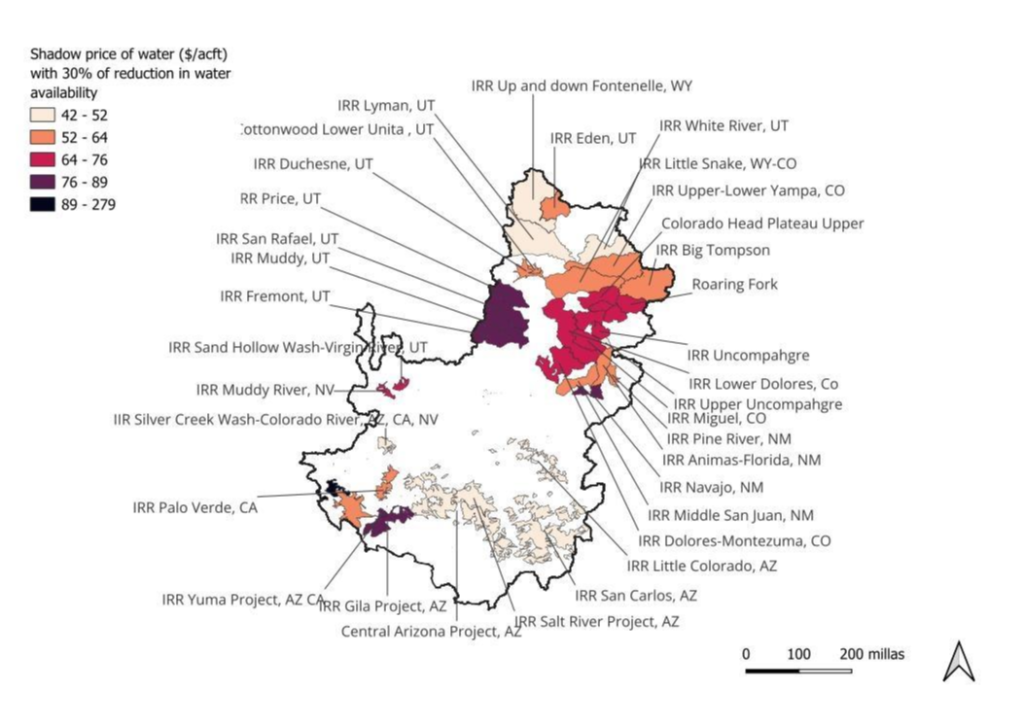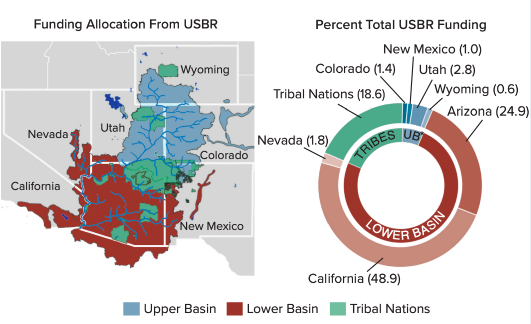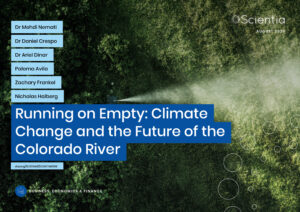Running on Empty: Climate Change and the Future of the Colorado River Basin
Amid growing pressures from climate change and population growth, water availability in the Colorado River Basin is declining while demand continues to rise. At the Water Dialogue Lab at the University of California, Riverside (UCR), Prof Mehdi Nemati and his colleagues, Dr Daniel Crespo, Prof Ariel Dinar, and Ms Paloma Avila from UCR’s School of Public Policy, along with Mr Zachary Frankel and Mr Nicholas Halberg from the Utah Rivers Council, have developed integrated models to assess changes in water availability, use, and associated economic values across the Basin. Their research evaluates the effects of climate change and policy interventions on both physical water supply and economic outcomes. Their findings highlight the need for adaptive planning, improved economic resilience, and policy reforms to ensure long-term sustainability in the region.
Climate change poses a global threat, but dry regions with already limited water face especially severe impacts. Agriculture is particularly at risk, as crops often depend on stable precipitation patterns, consistent temperatures, and reliable irrigation. As the climate shifts, these conditions grow increasingly unpredictable. Rising temperatures, changing precipitation, and evaporation patterns strain natural water systems and farmland. Crops now require more water to grow, but inconsistent precipitation and declining soil moisture make planning difficult, which adds to water stress and threatens local food security.
Shifts in how water moves—how much of it is used, stored in soil, evaporated, or falls as rain—ripple through the agricultural system. This uncertainty complicates decision-making for both farmers and policymakers. Water regulations often add to the challenge, as they don’t reflect current supply conditions. At the same time, water demand continues to rise due to increasing temperatures and population growth.
Researchers and water managers must identify who and what are most vulnerable—specific sectors, users, regions, and crops—and develop more efficient and adaptable water strategies. These actions are essential to safeguard both rural and urban communities, as well as the environment that depends on shared, limited water resources, and to support the development of efficient policies that address the impacts of climate change.
The Colorado River Basin: Vital Water in a Warming Climate
In recent decades, average temperatures increased by about 2.5°F (almost 1.4°C) in the Basin. This warming has reduced water availability and made severe droughts more frequent. Combined with unsustainable water use, it has pushed reservoir levels at Lake Powell and Lake Mead to historic lows. This has direct consequences for the populations, industries, and the environment that rely on the water of the Colorado River Basin (CRB). The CRB supplies drinking water to 40 million people across seven U.S. states—Colorado, New Mexico, Utah, and Wyoming (Upper Basin), and Arizona, California, and Nevada (Lower Basin)—as well as Mexico. It irrigates 2.2 million acres of farmland that support over 39 different crops. CRB also supports recreational and environmental water needs, in addition to generating electricity through hydropower.
Emergency conservation efforts are underway, but they reveal deeper problems: current water management strategies can’t meet today’s demands or future climate pressures. The system is at risk of collapse, which could trigger economic losses, water disputes, and ecosystem damage. A major issue is that outdated water allocation agreements don’t reflect the Basin’s actual conditions. Understanding the impacts of changes and the complex interactions among social, economic, hydrological, and policy components of the system is crucial to developing effective policies.

First Integrated Model Developed for the Whole CRB
Prof Mehdi Nemati and his colleagues at the University of California, Riverside, and the Utah Rivers Council have studied baseline water use across the CRB, disaggregated by sector, state, and user group. Using advanced modelling techniques, the team developed the first integrated model that combines both hydrological and economic data (known as a hydro-economic model) to explore the impact of multiple future scenarios. This model illustrates how the agricultural sector responds to different climate change scenarios, how the economic value of water changes across the Basin, and how conservation investments and the policy framework are strained under a changing climate.
Importantly, they present a comparative perspective across sectors and states rather than focusing on a single group, which allows the team to evaluate complex interactions across the Basin.
Assessing the Economic Value of Water in the CRB
The team developed a detailed model to better understand the value of water in the CRB, as it faces rising pressure from climate change, population growth, and outdated water allocation rules. Their model includes nearly 400 cities, major irrigation areas, and most of the Basin’s hydropower systems. It estimates that current water use across the region provides $20.6 billion in annual economic benefits—most of which ($18.3 billion) come from urban use.
The team found that while agriculture accounts for 85% of the water use, it generates only about 7% of the total economic benefit in the Basin. In contrast, cities, which use far less water, contribute nearly 90% of the total benefits. This gap reflects how water supports low-value crops such as hay and alfalfa in agriculture, compared to higher-value urban uses. Hydropower contributes a small share of the benefit but plays a broader role in water storage and flood control.
The team highlights that water is not currently allocated based on its most valuable use. Differences in irrigation methods, crop types, and water prices across regions influence the efficiency of use. The Lower Basin, including California and Arizona, tends to use water more productively than the Upper Basin.
The team argues that more flexible policies—such as water trading, allowing cities to buy water from farms—could improve efficiency and reduce pressure on stressed urban centres. However, they caution that reforms must consider side effects, such as impacts on ecosystems and downstream users.

Impact of Climate Change on Water Use and Availability
The team warns that failure to plan for a river system with much less water is a key challenge in the CRB today. At the heart of this system is a collection of treaties, laws, and court rulings known as the ‘Law of the River’, which began with the 1922 Colorado River Compact. This agreement allocated water between seven U.S. states, Mexico, Native American tribes, and for environmental needs. However, the original agreement was based on overly optimistic water flow estimates and excluded key groups such as tribes and environmental interests.
Over the past century, layers of policy—such as the 1944 treaty with Mexico and multiple Supreme Court decisions—have shaped how water is shared. Yet, as the team explains, these 20th-century frameworks are now faltering. Climate change has already reduced the river’s flow by about 20%, and scientists warn this could worsen. Despite several recent attempts to adapt—such as the 2007 Interim Guidelines and the 2019 Drought Contingency Plans—these measures have repeatedly underestimated the speed and severity of the river’s decline.
Inequalities in the system also persist. Native American tribes, despite having some of the oldest legal rights to the water, face complex barriers in accessing it. Meanwhile, some fast-growing urban areas receive disproportionately small water allocations based on outdated assumptions.

Federal Water Conservation Investments in the CRB
Various policy interventions aim to address this challenge, with federal government funding for supply and demand management being a key component, as seen in initiatives such as compensated conservation programs. The team analysed how the US Bureau of Reclamation (USBR), the primary source of funding for the basin water management, funds water conservation in the CRB. They examined 462 USBR-funded conservation projects in the CRB between 2004 and 2024. They found that $1.08 billion (in 2023 dollars) was allocated across two categories: 81% of the funding supported demand-side management projects, while approximately 19% funded supply-side initiatives.
On the demand side, funding was allocated to municipal and industrial projects ($493 million), agriculture ($311 million), and infrastructure ($62 million). On the supply side, investments included reuse ($77 million), local supply ($75 million), desalination ($50 million), and environmental projects ($17 million). Regarding geographic distribution, 5.7% of the funding was allocated to locations in the Upper Basin, 75.5% was directed to the Lower Basin, and 18.8% was designated for Tribal areas, some of which extend across both sub-basins. California alone received nearly half of the total funding, much of it supporting irrigation efficiency and long-term infrastructure improvements.
Reuse and agricultural projects were the most cost-effective, averaging $385 to $417 per acre-foot saved. Local supply projects are the most expensive, averaging $2,444 per acre-foot saved. The team emphasises that while a wide mix of conservation strategies is essential, future federal investment should focus on cost-effective projects—particularly in agriculture—to get the best return. They also highlight that simply saving water isn’t enough. Without clear policies to manage how that saved water is used, efficiency gains could lead to increased consumption elsewhere.

Climate Change Impacts on Agriculture in the CRB
The research team tested nine different climate scenarios, reflecting reduced river inflows and increased water demand by crops and simulating how these pressures might reshape farming over the next 30 years. As climate stress increases, total farmland shrinks—particularly for water-hungry crops like alfalfa and hay. These crops currently dominate the Basin but have relatively low economic returns. Under severe conditions, land used for farming could decline by up to 13%. The Basin also becomes less flexible, with fewer opportunities to recover during wet years. However, higher-value crops, such as vegetables and fruit trees, would remain relatively stable, as farmers prioritize their limited water supply to protect more profitable crops.
Irrigation methods could also shift. Flood irrigation, which uses large volumes of water, sees the sharpest decline. Drip irrigation, which is common for high-value crops, is the least affected. This reflects a strategic adaptation—preservation of economic returns by focusing on crops and methods that make the most efficient use of water.
Economically, even small annual declines in monetary returns of around 4% add up. Depending on the scenario, total losses could range from $440 million to $1.47 billion over three decades. States like Wyoming, Utah, and Colorado—heavily reliant on low-value crops—stand to lose the most. In contrast, California and Arizona fare better due to their greater share of high-value, water-efficient agriculture.
The team emphasises that these projections assume an ideal system where water is freely reallocated to maximise overall benefit. In reality, the rigid water rights system limits this kind of flexibility. To manage future uncertainty and safeguard the viability of farming, the researchers urge investment in more adaptive, efficient agricultural systems—both technically and through reform of water allocation policies.
Next steps
The hydro-economic model developed by the team for the CRB provides policymakers with a tool to test future scenarios, including climate change, population growth, and changes to existing water regulations. The hydro-economic model also enables policymakers to compare the efficacy of various policy interventions being considered for addressing water resource management in the Basin. While this tool can’t change who makes decisions, it could make those decisions more transparent and better informed. The team hopes this can support more balanced, transparent, and adaptive strategies for managing one of North America’s most important and overstretched water systems.
Looking ahead, the researchers stress that bold, forward-thinking policies are urgently needed. Without them, old agreements will continue to buckle under new and intensifying realities.
SHARE
DOWNLOAD E-BOOK
REFERENCE
https://doi.org/10.33548/SCIENTIA1308
MEET THE RESEARCHERS

Dr Mehdi Nemati
School of Public Policy, University of California, Riverside
Dr Mehdi Nemati is an Assistant Professor of Environmental Economics and Policy at the School of Public Policy, University of California, Riverside. Dr Nemati earned his PhD in Agricultural Economics and his MS in Economics from the University of Kentucky. He also holds an MS in Agricultural Economics from the University of Tehran, Iran. With a strong focus on applied econometric methods and big data analysis, Dr Nemati’s policy-oriented research centered around economic issues associated with water management. He actively collaborates with government agencies and industry leaders in California and beyond to tackle pressing water policy challenges. He currently leads the Water Dialogue lab at UC Riverside.
CONTACT
Website

Dr Daniel Crespo
School of Public Policy, University of California, Riverside
Dr Daniel Crespo is a Postdoctoral Researcher at the School of Public Policy, University of California, Riverside. His research interests include environmental and natural resource economics, environmental and agricultural policy, water modeling and optimization, water management, water scarcity and drought, and climate change. He holds a PhD in Economics from the University of Zaragoza.
CONTACT

Dr Ariel Dinar
School of Public Policy, University of California, Riverside
Ariel Dinar is a Distinguished Professor of Environmental Economics and Policy, Emeritus at the School of Public Policy, and a Professor of the Graduate Division at the University of California, Riverside (UCR), United States. His work has focused on various aspects of economic and strategic behavior associated with the management of natural resources and the environment. Prof Dinar received his PhD from the Hebrew University of Jerusalem in 1984.
CONTACT

Paloma Avila
School of Public Policy, University of California, Riverside
Paloma Avila holds a Master of Public Policy from the University of California, Riverside, with a concentration in environmental policy. As a Graduate Student Researcher, they contributed to projects on water governance, policy design, and the equitable management of water resources. Paloma also has experience in the nonprofit sector, serving as a contract grant writer with the Trust for Public Land, where they supported initiatives in watershed health across California.
CONTACT

Zachary Frankel
Founder and Executive Director, Utah Rivers Council
Zachary Frankel is the founder and Executive Director of the Utah Rivers Council. Zach has been working on water education and conservation across the American West for over 25 years. He successfully led a campaign to stop a 257-foot high proposed dam on the Diamond Fork River in 1997 and authored Utah’s first water conservation law, the Utah Water Conservation Plan Act, which was passed in 1998 by the Utah State Legislature.
CONTACT

Nicholas Halberg
Research and Policy Analyst, Utah Rivers Council
Nicholas Halberg is a Research and Policy Analyst at the Utah Rivers Council. His role is to research various scientific topics associated with water policy and translate those findings into understandable and implementable policy actions inside the Colorado River Basin. Nicholas graduated magna cum laude from the University of Utah, where he received a honors BS in economics and a BS in philosophy of science.
CONTACT
FUNDING
We are grateful for the support from the UC Riverside OASIS Internal Funding Award (OASISIFA), W4190 Multistate NIFA-USDA project, “Management and Policy Challenges in a Water Scarce World,” and the Giannini Foundation of Agricultural Economics.
FURTHER READING
D Crespo, M Nemati, A Dinar, et al., Hydro-Economic Analysis of the Colorado River Basin: A Comprehensive Framework for Water Management,” SPP Working Papers Series.
D Crespo, M Nemati, A Dinar, et al., Assessing the Economic Value of Water in the Colorado River Basin: A Hydroeconomic Analysis, In preparation.
A Paloma, M Nemati, D Crespo, et al., Funding the Flow: Federal Water Conservation Investments in the Colorado River Basin, ARE Update 28(4): 9–11, 2025, University of California Giannini Foundation of Agricultural Economics.
Z Frankel, N Halberg, M Nemati, et al., Climate Crisis is Straining the Colorado River’s Complex Policy Architecture. Choices Magazine, 2024.
D Crespo, M Nemati, A Dinar, et al., Chapter 11: Climate change impacts and adaptation in the agricultural sector of the Colorado River Basin: A hydro-economic analysis.


REPUBLISH OUR ARTICLES
We encourage all formats of sharing and republishing of our articles. Whether you want to host on your website, publication or blog, we welcome this. Find out more
Creative Commons Licence (CC BY 4.0)
This work is licensed under a Creative Commons Attribution 4.0 International License. 
What does this mean?
Share: You can copy and redistribute the material in any medium or format
Adapt: You can change, and build upon the material for any purpose, even commercially.
Credit: You must give appropriate credit, provide a link to the license, and indicate if changes were made.
SUBSCRIBE NOW
Follow Us
MORE ARTICLES YOU MAY LIKE
Professor Yves R. Sagaert | Demand Planning Excellence: The Case for Incorporating Macroeconomic Leading Indicators
Today’s demand planning landscape is increasingly defined by radical uncertainty. Professor Yves R. Sagaert from the research group Predictive AI and Digital Shift at VIVES University of Applied Sciences is one of many scholars who posits that to survive and thrive in this new normal, demand planners must consider incorporating leading macroeconomic indicators into their demand forecasts. This field of research is vital for better understanding how the early warning signals in leading macroeconomic indicators can be used to inform precision forecasting and minimise forecast-reality variance.
Dr Alexander Scholze | Digital Transformation in the Workplace: Navigating the Balance Between Demands and Resources
What if your digital tools, designed to help you, became the very reason for your burnout? In today’s rapidly evolving digital landscape, organisations face the challenge of implementing technological changes while safeguarding employee well-being. Dr Alexander Scholze has developed a theoretical framework that comprehensively examines how digitalisation affects workplace dynamics, particularly focusing on job demands and resources. His research offers valuable insights for organisations seeking to harness the benefits of digital transformation while mitigating potential negative impacts on employee health and motivation.
Professor Jean-Philippe Bouchaud | The Inelastic Market Hypothesis: Explaining the Origins of Financial Fluctuations
What drives movements in asset prices? Are markets efficient, with prices reflecting underlying fundamentals, or do uninformed trades impact prices long-term? Professor Jean-Philippe Bouchaud from Capital Fund Management and Académie des Sciences has devoted his career to developing models that can explain the complex dynamics of financial markets. His work provides compelling evidence that order flow itself, rather than just incoming information, is the primary driver of price changes. This finding has important implications for our understanding of markets and the strategies of traders, fund managers and policymakers.
Christopher Gilbert | A Thorough Inquiry into Copper Super-Cycles
Understanding super-cycles is crucial for stakeholders such as investors, policymakers, and industry leaders as it offers insights into long-term trends and dynamics in commodity prices. Christopher Gilbert plays a pivotal role in providing stakeholders with the foresight needed to navigate fluctuations in metal prices and volatile markets confidently.





